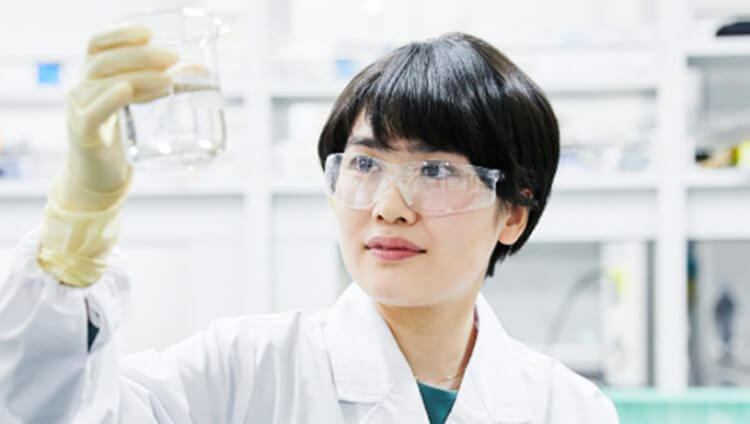Glossary of Amino Acids
Acetaldehyde
Alcohol becomes acetaldehyde in the liver. It is then further oxidized into acetic acid and finally broken down into carbon dioxide for energy production. The acetaldehyde that is made in this process makes our faces red and triggers other effects when we drink alcohol.
Active site of enzyme
Enzymes speed up reactions in various substances. The part of the enzyme that is directly involved in this reaction is called the active site.
Aerobic exercise
Aerobic exercise is endurance exercise that efficiently uses energy by the tricarboxylic acid (TCA) cycle while using large amounts of oxygen over an extended period. Running a marathon, swimming and tennis are examples of aerobics exercise.
Alanine
An amino acid that is an important source of glucose in the liver. It support function of the liver.
Amines
Amines are often made in the body from amino acids. Many amine hormones influence the way our bodies function and how our nervous system works. Epinephrine (adrenaline), norepinephrine (noradrenalin), serotonin and histamine are all amines that are made in the body.
Amino acid infusions
Amino acid infusions were developed to help stomach and intestinal surgery patients get enough nutrition intravenously. These infusions have made it much easier to manage the nutrition of patients who are unable to take in enough food. Without these infusions, these patients would suffer from protein deficiency and severe malnourishment.
Amino acid score
A numerical value for evaluating the quality of a protein.
It is called a limiting amino acid that is less than the amino acids scoring pattern defined by the international organizations (FAO / WHO / UNU) . Amino acid score is a numerical value showing how much the smallest limiting amino acid satisfies the scoring pattern.
A protein with an amino acid score close to 100 can be said to be a good quality protein.
Arginine
An amino acid that works to ensure normal vascular function.
Aromatic amino acids
Amino acids that have an aromatic ring (phenylalanine, tryptophan and tyrosine) are called aromatic amino acids. These aromatic amino acids are used to make hormones and various amines in the body. They are also used as a component to make proteins.
Asparagine
An amino acid that was discovered and isolated from asparagus.
Aspartame
Each amino acid has a different taste. Aspartame is a sweetener made of two amino acids asparagine and phenylalanine. Aspartame is 200 times sweeter than sugar, and is used as a low-calorie sweetener.
Aspartate
Both asparagine and Aspartate are positioned close to the tricarboxylic acid (TCA) cycle in energy production.
Basal metabolism
Basal metabolism is the body’s metabolization of energy at rest. Young people typically have a high basal metabolic rate but it slows as we get older.
BCAA infusion
Branched-chain amino acids (BCAAs) help reduce the breakdown of proteins in the body. BCAA-rich infusions are widely used by hospitals to prevent the loss of protein in the body after surgery.
BCAA oral supplementation
Branched-chain amino acids (BCAAs) are often used to manage the nutrition of patients after surgery or for people with liver disease. BCAA oral supplementation is a treatment where patients take BCAA supplements orally.
Biodegradability
Biodegradation means the process of microorganisms that exist in nature gradually breaking down substances into natural elements. Amino acids are plentiful in nature and are quickly broken down and used in nature. This makes amino acids highly biodegradable and environmentally friendly.
Branched-chain amino acids
Valine, isoleucine and leucine are called branched-chain amino acids (BCAAs). BCAAs are important for promoting protein growth in the body, improving liver function and providing energy during exercise.
Citric acid
Citric acid is a substance in the tricarboxylic acid (TCA) cycle, which generates energy in the body. The TCA cycle starts with citric acid and is also called the “citric acid cycle.”
Collagen
Collagen is a protein that makes up skin, ligaments and cartilage. Roughly one-third of the protein in the body is collagen. It is made from the amino acids alanine and proline.
Cuticle
The cuticle is the outermost part of the hair and is mainly made from protein. Daily environmental stresses such as getting permanent waves, applying hair dyes, exposure to ultraviolet radiation and washing can damage cuticles over time.
Cysteine
Cysteine is an amino acid that reduces the amount of black melanin pigmentation made in skin.
Cystine
Cystine is made when two cysteine amino acids join together. Cystine is plentiful in chicken meat and our bodies use cystine to make various substances including protein and glutathione. Cystine also promotes the normal function of immune cells.
Enzymes
Enzymes are proteins that speed up reactions to turn certain substances into other substances. Enzymes are a type of protein and are made from amino acids.
Epinephrine
Also called “adrenaline,” epinephrine is a hormone that is secreted to help the body’s immediate stress response. It does this by raising your heartbeat or blood pressure. Epinephrine is made in the body from the amino acids phenylalanine and tyrosine.
Essential amino acids
There are 20 amino acids that make up protein. Nine of them (histidine, isoleucine, leucine, lysine, methionine, phenylalanine, threonine, tryptophan and valine) cannot be made by our bodies and must be consumed in food. These are called essential amino acids.
FAO/WHO/UNU
An acronym for the Food and Agriculture Organization of the United Nations (FAO), World Health Organization (WHO), and United Nations University (UNU). These international bodies work to address various food security and public nutrition issues in different countries. FAO/WHO/UNU have jointly defined the reference pattern of amino acid requirements (ideal amino acid composition) in human nutrition.
Free amino acids
Some individual and unbound amino acids are contained in blood and cells, so that they can be immediately used by the body. These are called free amino acids, and are rapidly used in the body when they are needed.
Gluconeogenesis
Brain and muscle tissue continuously use glucose for energy and the body can make many different nutritious substances from sugars. Amino acids are typically used to make glucose. These processes are called gluconeogenesis.
Glucose
Glucose is one of the most important sources of energy in the body. In food our bodies get glucose by digesting starches. Blood sugar level is another way of referring to the glucose level in blood.
Glutamate
Glutamate is the base of umami and free glutamates are found in kombu, tomatoes and cheese. Inside the body, glutamate is utilized as an important source of essential amino acids.
Glutamine
Glutamine is an amino acid that is needed to maintain normal gastrointestinal and muscle function.
Glutathione
Glutathione is a peptide (short chain of amino acids) made from glutamate, cysteine and glycine. Glutathione protects the body from oxidants and promotes the normal function of immune cells.
Glyceric Acid
Glyceric acid is an important substance for our bodies to make phospholipids, sugars and serine.
Glycine
A non-essential amino acid that is made in the body. Glycine is plentiful in the body. It acts as a transmitter in the central nervous system and facilitates the regulation of some physiological functions such as locomotion and sensory perception. Glycine makes up one-third of collagen.
High-calorie infusions
High-calorie infusions are infusions used for the nutritional management of patients who are unable to eat food orally. High-calorie infusions are used by combining a base solution (sugar and electrolyte infusion) and an amino acid infusion.
Histamine
Histamine is an important substance used for allergy response by the body. Histamine is made from histidine.
Histidine
An essential amino acid that is used to make histamine.
Immune antibodies
Immune antibodies are proteins that are made in order to attack and remove viruses and foreign invaders that enter the body. Antibodies are made from amino acids.
Immune cells
Immune cells are a type of white blood cell. They are also called lymphocytes. There are various lymphocytes in the body and they work together to remove viruses and other substances that attack the body.
Isoleucine
A branched-chain amino acid (BCAA) together with valine and leucine. Isoleucine plays an important role in promoting protein growth in the body and providing energy during exercise.
Keratin
Keratin is a protein that is plentiful in hair, nails and skin and helps to protect the body. Keratin is rich in sulfur-containing amino acids such as methionine.
Koji
Koji or aspergillus oryzae is a culture that is used to make sake and soy sauce. Koji promotes the breakdown of protein and starch in grains and beans.
Lactic acid
Our bodies make lactic acid when using sugars to produce energy. Our bodies only make a small amount of lactic acid in everyday life. However, if you suddenly start exercising or increase your exercise intensity, it can sharply increase the breakdown of sugars. This then causes a temporary and proportional increase the amount of lactic acid made. After the lactic acid is made, it is used by the body to produce energy, just like sugars.
Leucine
A branched-chain amino acid (BCAA) together with valine and isoleucine. Leucine plays an important role in promoting protein growth in the body and providing energy during exercise. Recent research indicates older persons need more leucine as they age.
Lysine
Lysine is one of the most commonly mentioned essential amino acids. Foods such as bread, wheat noodles and milled rice tend to be low in lysine.
Macrophage
Macrophages destroy viruses and other substances that attack the body. Microphages are always floating in the blood.
Melanin
Melanin pigments are the most important pigments in skin. Black melanin provides a black pigment. When you get sunburnt, the amount of black melanin increases. The amino acid cysteine reduces the amount of black melanin pigment made.
Methionine
An essential amino acid that is used to make many different substances needed in the body
Natural moisturizing factor
Skin has a natural moisturizing factor (NMF) that is mainly made up of amino acids. The natural moisturizing factor retains moisture and keeps the skin smooth and supple by forming a layer of fat that is a barrier to the outside.
Non-essential amino acids
Amino acids that can be made by our bodies are called non-essential amino acids. Other amino acids are essential amino acids. Scientists are increasingly discovering the many different functions of non-essential amino acids.
Norepinephrine
Also called noradrenaline, norepinephrine is a hormone that is secreted to help the body’s immediate stress response by raising your blood pressure. Norepinephrine is made in the body from the amino acids phenylalanine and tyrosine.
Nucleic acids
Nucleic acids, which include inosinic acid and guanylic acid, are known as umami substances. Inosinic acid is plentiful in meat and fish while guanylic acid is plentiful in mushrooms.
Oxaloacetic acid
Oxaloacetic acid is a substance in the tricarboxylic acid (TCA) cycle that produces energy in the body.
Phenylalanine
An essential amino acid that is used to make many types of useful amines.
Phospholipids
Phospholipids are essential for making cell membranes. Phospholipids are abundant in cells and blood. Eggs and soy are foods with lots of phospholipids.
Porphyrins
The red pigment of blood comes from porphyrin in red blood cells. Porphyrin binds with iron to help iron bind with red blood cells.
Proline
An amino acid that is the main ingredient of collagen, which makes up skin.
Proteins
Proteins are made by chains of 10 or more amino acids or sometimes even hundreds of amino acids. Proteins make up many different components in the body including muscles and organs. Some hormones and enzymes are also made from proteins.
A protein with an amino acid score close to 100 can be said to be a good quality protein.
Pyrrolidone carboxylic acid
Pyrrolidone carboxylic acid (PCA) is an amino acid derivative. It is a moisturizing substance and is plentiful in the natural moisturizing factor (NMF) of skin.
Pyruvic acid
Alanine and sugars are first converted to pyruvic acid. This is then converted to citric acid before entering the tricarboxylic acid (TCA) cycle where it is burned for energy. Pyruvic acid is one of the inputs of the TCA cycle.
Sarcopenia
Sarcopenia is the natural loss of skeletal muscle mass as we get older. As sarcopenia progresses, our strength and endurance typically decreases. It can even lead to the need for assistive care.
Serine
An amino acid used to make phospholipids and glyceric acid.
Serotonin
Serotonin in the brain helps to regulate body temperature, sleep and appetite. When animals repeatedly exercise for long periods of time the amount of serotonin increases in the brain. That’s why scientists believe there is a strong connection between serotonin and fatigue. Serotonin is made in the body from the amino acid tryptophan.
Sulfur-containing amino acids
Amino acids such as methionine and cystine are called “sulfur-containing amino acids” because they contain sulfur.
Theanine
Theanine is an amino acid that was discovered in tea leaves and is plentiful in high-grade teas such as green tea. Theanine is metabolized into glutamate and ethylamine in the body.
Threonine
An essential amino acid that is used to make the active site of enzymes.
Tricarboxylic acid cycle
The tricarboxylic acid (TCA) cycle, also called the citric acid cycle, breaks down amino acids, sugars and fats to produce energy.
Tryptophan
An essential amino acid used to make many types of useful amines.
Turnover
Turnover is the process of protein in the body being replaced with new protein. This can take several minutes or even several months. Skin turnover, for example, is the cycle of new skin being made, used on the outermost part of the body and shed off when it is used up.
Tyrosine
Tyrosine is used to make many types of useful amines. Tyrosine is an aromatic amino acid together with phenylalanine and tryptophan.
Umami substances
A substance that produces umami, one of the five basic tastes. Known umami substances include glutamate from kombu, inosinic acid from bonito fish shavings, and guanylic acid from dried shiitake mushrooms. Glutamate is plentiful in cheeses and vegetables. Inosinic acid is plentiful in meat and fish. Guanylic acid is plentiful in mushrooms.
Valine
A branched-chain amino acid (BCAA) together with isoleucine and leucine. Valine plays an important role in promoting protein growth in the body and providing energy during exercise.
Content you may like

What Are Amino Acids? Essential Nutrients for All Life
Amino acids are organic compounds that make up proteins and are the source of our very life. This article provides an overview of amino acids, ...

Amino Acids for Healthy Aging
Leveraging amino acids to extend healthy life expectancy Amino acids are important for addressing loss of muscle mass as we ageAs we get older, we ...

Amino Acids and Alcohol
Amino acids (alanine and glutamine) assist liver function. Alanine and glutamine are glucogenic amino acids that make glucose in the body to provide energy. Taking ...
